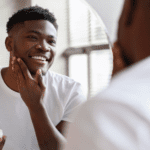Self-acceptance can be a journey, especially when dealing with a visible condition like vitiligo. At NOWINCLUDED, we believe in the power of sharing real-life experiences to create an understanding and supportive community. One of our community members, Theo, shared his story with us, showing how he’s embraced life with vitiligo, stayed strong, and found acceptance.
Discovering Vitiligo
Theo first noticed vitiligo in the eighth grade, around 13 or 14 years old. It started as a small patch and gradually spread, mostly on his face and other parts of his body. But he didn’t let it stop him from living a normal life.
“I played football, sports, had friends, and girlfriends. I felt normal. It really didn’t impact me that much,” he reflects. “I was lucky because I had good support from my family and friends.”
Vitiligo, a condition where the skin loses its pigment cells, affects about 1% of the global population. In the United States, it’s estimated that 0.5% to 1% of the population, including people of all races and ethnicities, are living with vitiligo. However for Black people, its effects go beneath the surface. The contrast in skin tones can challenge societal beauty standards, making the condition more noticeable and sometimes more psychologically challenging.
Resilience and Self-Acceptance
Theo’s journey is all about resilience and self-acceptance. While vitiligo can bring unique challenges, especially around strangers, he never felt defined by it.
“I had a friend with one arm, and after a while, you just don’t see that anymore. You see the person for who they are,” he says. “People around you, family, friends, coworkers – they see you for the person you are.”
He knows how important it is to have a supportive network. He realizes that vitiligo can affect people differently, but his positive attitude and supportive environment made his journey easier.
One big challenge he mentions is the lack of knowledge about vitiligo. “Some people think it’s a burn or only affects dark-skinned people, but vitiligo is just pigment loss. It can happen to anyone,” he explains.
Public awareness about vitiligo has improved a lot since he was first diagnosed. Today, more people know what it is. “There’s even a commercial now narrated by Morgan Freeman about a new medication for vitiligo,” he notes, highlighting progress in awareness and treatments.
Looking Forward
Theo is hopeful about the future of vitiligo research and treatment. “The public knowledge and treatment options have grown a lot since I first realized I had vitiligo. There’s a new cream that can help bring back some pigmentation (color),” he shares.
While Theo has not participated in any clinical research, also known as clinical trials, he remains open to the possibility, especially if it means advancing understanding and treatment for others with vitiligo.
Embracing Life Fully
When asked what advice he’d give to someone newly diagnosed with vitiligo, his message is clear: “Just keep living. Do what you want to do, go where you want to go. Confidence is key. People are not always looking at your vitiligo. They see you for who you are.”
His story reminds us that our worth isn’t about how we look but about our actions, personality, and how we choose to live. Despite initial shyness, he learned to embrace life fully and not let vitiligo hold him back.
“I’ve always had confidence. I don’t know if it was my parents that gave it to me or what, but I wouldn’t be ashamed to go anywhere,” he says. “People with vitiligo shouldn’t feel ashamed either. Just live your best life.”
Theo’s story is a reminder of the strength we all have inside us. At NOWINCLUDED, we’re inspired by his journey and committed to sharing more stories like his. Everyone’s story is worth sharing, and by listening, we can build a more inclusive and compassionate world.
For more resources and personal stories about living with vitiligo, check out our related article, The Skin You’re In or join our hair and skin health circle. Thanks for sharing your journey with us, Theo. Keep living your best life!
You Might Also Like:

These Chipotle Swaps Will Save Your Gut & Skin
If you’ve ever left Chipotle feeling a little bloated or noticed your skin flaring up the next day, you’re not imagining things. These simple swaps could help your gut and skin health thrive.

Is Your “Waterproof” Sunscreen Lying to You?
As we slather on sunscreen, many of us reach for those bottles proudly proclaiming “waterproof” or “water resistant.” But have you ever stopped to wonder what those claims truly mean?









